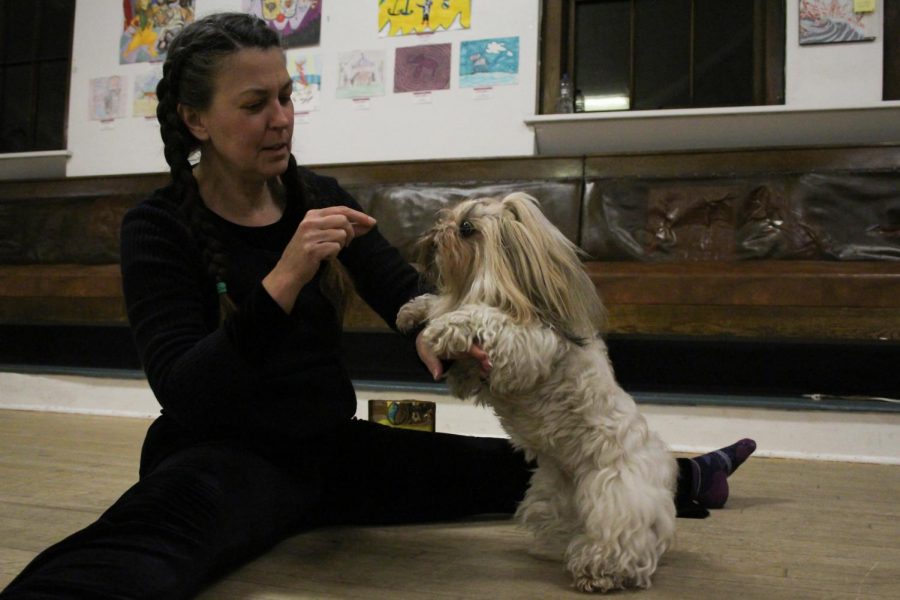Dance depression away, feel proud of your body
Choreographers said music, movement help to manage grief, pain
KIERSTEN BUTTERWORTH | THE DAILY EVERGREEN
Dance instructor Shelly Werner dances with her 11-year-old Shih Tzu-Maltese poodle mix Roxy on Monday night at Moscow Yoga Center. Roxy attends Werner’s classes.
March 19, 2019
Dance is an art, a sport, and a reliever for depression. It can ease depression and give you pride in your body.
Shelly Werner, teacher of art and dance classes at Spectrum 11 Art and Dance Studio, has danced since she was 4 years old.
In 1995, she began teaching dance classes at the studio. Werner also received a Master’s in dancing degree at University of Idaho. She said dance adds meaning to her life.
“I love choreography,” Werner said. “I began creating dances at 8.”
Werner said she stopped dancing for two years after she graduated from the University of Idaho and instead taught art for this time. She said not dancing was awful and when she started again, she was more comfortable with herself.
Leah Knibbe, a legal assistant and dance major at University of Idaho, dances with Werner. She said when she dances, she relieves pains in her body, both emotional and physical.
She also said she is more aware of her space that her body takes up. Knibbe said dance helped her with self-confidence and even her depression.
“I have come to realize that this is the space I fill,” Knibbe said. “I do hand gestures and I move out like a starfish to take up more space. There is plenty of space for everyone and I deserve to have this space in the world, and I am going to take it.”
Werner said a teacher told her dance would help with depression.
“Think of dancing and depression like a hot air balloon,” Werner said. “Once it’s over, it floats down, it doesn’t pop and plummet to the ground and pick the pieces up like Humpty Dumpty.”
After Werner’s father died, she fell into hard times. She tried to continue dancing but was struggling to cope with his death. She said she visited him every day for four years and she loved her him.
Werner said she used a type of dance called the wave, that Werner calls “ecstatic dancing.”
“When I was doing ecstatic dance, I could imagine the ropes of a mop that was a psychic tie to my dad. I couldn’t move and I felt stuck and heavy with cement boots,” Werner said. “I was underwater with these ropes, and I felt cut off from my dad. It was physically painful … I eventually could dance and move again.”
Werner said she could only imagine how someone could go through the same experience without realizing that dance could help find their voice.
Whether someone is in a funk or wants a new hobby, dance can be a great outlet and an insightful physical experience. To lift her spirits, Werner dances with her 11-year-old Shih Tzu mix named Roxy.
Roxy attends all of Werner’s classes and dances for treats.
“I danced ever since I could remember,” Knibbe said. “I remember doing the macarena on loop for an absurd amount of hours on my boombox in the front yard.”
Werner’s favorite dance styles are contemporary and modern.
“I am 56 and I have to try harder at what I do,” Werner said. “But I love to [dance] anything from contemporary to hip hop and belly dancing.”
Both women said dance is a puzzle and it’s interesting to learn how to move your body to the way someone else’s body moves.
“I found from experience that people who are gifted get bored,” Werner said. “But I found people who aren’t as talented are those who keep at it and really work hard.”
Knibbe said she would swing dance growing up but didn’t pick up dancing until she was at the University of Idaho.
Once she took a ballroom dancing class, it made her realize that dance needed to be in her life, Knibbe said.
“I dance when I am walking, cleaning my room or just in general,” Knibbe said.
One time Knibbe nearly walked into a wall, but naturally spun with a move she’d learned in dance. She ended up walking side by side with everyone else in the hall.
Knibbe said that different dancing styles affect her mood. When she dances in a hip-hop style she said she feels relaxed and calm. When she finishes a ballet routine she feels ready to keep going and stay up all night.
Werner said that the best part of dancing is knowing you can dance your way out of a funk.









